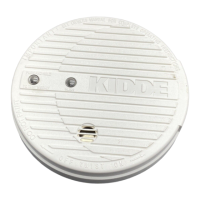NOTE: THE TAMPER RESIST PIN WILL HAVE TO BE REMOVED
IN O RDER TO CHANGE THE BATTERIES. USE LONG NOSE PLI-
ERS TO PULL THE PIN OUT OF THE HOLE. IT IS NOW POSSI-
BLE TO REMOVE THE ALARM FROM THE MOUNTING PLATE.
8. After installati on, test your alarm by depressing and holding
down the test button for at least 5 seconds . This should sound
the alarm.
4. OP ERATION AND TESTING
OPE
R
ATION: The smoke alarm is operating once a fresh battery is
installed and testing is complete. When products of combustion
are sensed, the unit sounds a loud 85db pulsating alarm until the
air is cleared.
HU
S
H CONT
R
O
L
: The “ HU
S
H” feature has the capability of tem-
porarily desensitizing the alarm circuit for approximately 7 minutes.
This feature is to be used only when a known alarm condition,
such as smoke from cooking, activates the alarm. The smoke
alarm is desensitized by pushing the “HU
S
H” button on the smoke
alarm cover. If the smoke is not too dense, the alarm will silence
immediately and “chirp” every 30-40 seconds for approximately 7
minutes. This indicates that the alarm is in a temporarily desensi -
tized condition. The smoke alarm will automatically reset after
approximately 7 minutes and sound the alarm if particles of com-
bustion are still present. The “HU
S
H” feature can be used repeat-
edly until the air has been cleared of the condition causing the
alarm. Pushing the test/reset button on the alarm will end the
hush period.
NOTE: DENSE SMOKE WILL OVERRIDE THE HUSH CONTROL
FE ATURE AND SOUND A CONTINUOUS ALARM.
CAUTION: BEFORE USING THE ALARM HUSH FEATURE, IDEN-
TIFY THE SOURCE OF TH E SMOKE AND BE CERTAIN A SAFE
C ONDITION EXISTS.
F
L
A
S
HING
L
ED
L
IGHT: This smoke alarm is equipped with a flash-
ing red indi cator light. The light is located under the test button
and will flash every 30 - 40 seconds to indicate that the smoke
alarm is receiving power.
TE
S
TING: Test by pushing the test button on the cover and holding
it down for a minimum of 5 seconds. This will sound the alarm if
the electronic circuitry, horn, and battery are working. If no alarm
sounds, the unit has defective batteries or other failure. DO NOT
use an open flame to test your alarm, you could damage the
alarm or ignite combustible materials and start a structure fire.
TE
S
T THE A
L
A
R
M WEEK
L
Y TO EN
S
U
R
E P
R
OPE
R
OPE
R
ATION. Erratic
or low sound coming from your alarm may indicate a defective
alarm, and it should be returned for service
(
see section 12
)
.
NOTE: WEEKLY TESTING IS REQUIRED.
5. NUISANCE ALARMS
S
moke alarms are designed to minimize nuisance alarms.
Cigarette smoke will not normally set off the alarm, unless the
smoke is blown directly into the alarm. Combustion particles from
cooking may set off the alarm if the alarm is located close to the
cooking area.
L
arge quantities of combustible particles are gener-
ated from spills or when broiling. Using the fan on a range hood
which vents to the outside
(
non-recirculating type
)
will also help
remove these combustible products from the kitchen.
If the alarm does sound, check for fires first. If a fire is discovered,
get out and call the fire department. If no fire is present, check to
see if one of the reasons listed in section 2 may have caused the
alarm.
6. MAINTENANCE
BATTERY REPLACEMENT
If tamper resist pin has been used, refer to TAMPE
R
R
E
S
I
S
T
L
OCK-
ING PIN in section 3 for removal instructions.
To replace the battery, remove the alarm from the mounting plate
by rotating the alarm in the direction of the “ OFF ” arrow on the
cover
(
see figure 7
)
.
The Model 0916
S
moke Alarm is powered by a 9V carbon zinc
battery
(
alkaline and lithium batteries may also be used
)
. A fresh
battery should last for one year under normal operating condi-
tions. This alarm has a low battery monitor circuit which will
cause the alarm to “chirp” approximately every 30 - 40 seconds
for a minimum of seven
(
7
)
days when the battery gets low.
R
eplace the battery when this condition occurs.
USE ONLY THE FOLLOWING 9 VOLT BATTERIES FOR SMOKE
ALARM BATTERY REPLACEMENT.
Carbon-zinc type: EVE
R
EADY 216 O
R
1222; GO
L
D P EAK 1604P
O
R
1604
S

